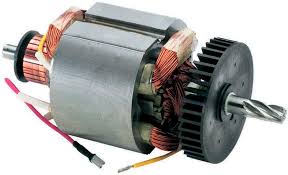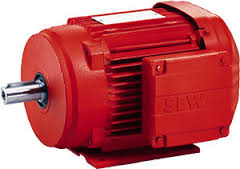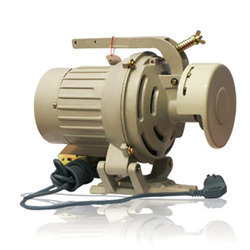Motors for bag closing sewing machines
1-phase series motor
For portable machines
Motors for portable sewing machines with a cord are single phase series-type motors. It means the stator-windings and rotor-windings are in series. The rotor uses carbon-brushes for feeding the rotor with a rotor current. The motor-speed is mainly influenced by the mechanical load, but also by the mains frequency. The speed is not very stable. This type of machines cannot be used in combination with infeeders or conveyor-belts. Typical rpm-range (rotations per minute) is 6.000 – 10.000. These motors have a high starting torque. The carbon brushes cause sparks that will cause electrical interference signals. A CE-compliant filter is needed to suppress electrical interference, if required in your country. The rotation-direction cannot be changed.
For cordless machines a low-voltage motor is available, together with a battery-belt. Typical motor-voltages are 12 Volt or 36 Volt motor/battery combinations.
A 230V sewing machine can also be used in combination with a 12V to 230V converter to make it portable. A 12Volt car or tractor battery can be used in that case.
3-phase induction motor
For machines in a fixed position
On a pedestal
These sewing machines always need a 3-phase brushless asynchronous type induction motor. There speed is accurate if the motor power is oversized (to prevent speed-slips). Typical speeds for a 50 Hz mains-frequency are: 2950 rpm for a 2-pole motor, or 1450 rpm for a 4-pole motor. Speeds are 20% higher for a 60 Hz mains frequency. The rotation direction of the motor can easily be changed by exchanging any 2 out of 3 phase-wires. A most-used motorspeed is 1450 rpm.
3-phase motor voltages are v3 * 230V (single phase voltage in Europe) = 400 Volts, or v3 * 120 for USA= 208 volts. A typical motorsize is a 550 Watt motor.
1-phase clutch motor
On a sewing-table
For this application a single phase clutch-motor (brushless, asynchronous induction type) is often used. The motor has a poor starting torque. The motor runs all the time, and is mechanically connected to the sewing-machine by means of a clutch, actuated by means of a foot-pedal. A V-belt connects the sewing-machine with the motor. The speed can be varied slightly with the pedal by means of slipping (like in a car with manual gear and clutch).
The final speed cannot be influenced. The rotation-direction can easily be changed by rewiring the phase-capacitor.
A better (newer) option is to use the AC-servo motor. The motor only runs when needed. Speed and torque are electronically controlled. In contrast with the clutch-motor, the pedal is now used for starting the motor and changing speeds. Speed-range settings, soft starts and change of rotation-direction are standard features amongst others. Optionally the needle-position can be controlled by means of an external synchroniser, attached to the machine pulley-shaft. The needle can stop automatically in the high position for instance.
Synchronisation options and issues
Synchronising the speed between the sewing-motor, an optional infeeder and a conveyor-belt can be done in typically two ways.
- With variable pulleys (mechanicallly adjustable). This will be time-consuming, also because the distance between the pulleys will vary as well.
- By means of frequency inverters in series with the 3-phase motor. (variations not more than 20% , otherwise torque-problems will be experienced)
As a start in the speed design it is good practice to select the motorspeed in such a way that pulley-sizes for the motor and the sewing machine have much the same size.
The maximum specified speed of the sewing machine (other than motor-speed) must not be exceeded !
When an infeeder is used, the sewing-speed (centi-meters/second) must be 2% higher than the infeeder-speed (centi-meters/second).
The best way to check the speed is by means of a tacho-meter, and reflectors, attached to the test-bag. Test with no yarn installed.
Explosion proof environments
Use ATEX compliant parts in this case (Motors, belts,sensors and/or make use of cabinets with overpressure to prevent dust from coming in).



